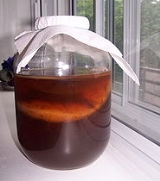
Kombucha
Overview
Kombucha is an effervescent tea-based beverage that is often drunk for its anecdotal health benefits or medicinal
purposes. Kombucha is available commercially and can be made at home by fermenting
tea using a visible, solid mass of yeast
and bacteria
which forms the kombucha culture, often referred to as the "mushroom" or the "mother".
The culture mainly contains a symbiosis of Acetobacter
(acetic acid bacteria) and one or more yeast
s.
The culture itself looks somewhat like a large pancake, and though often called a mushroom
, a mother of vinegar
or by the acronym SCOBY
(for "Symbiotic Culture of Bacteria and Yeast"), it is scientifically classified as a zoogleal mat.
Folk medicine
-Description:Refers to healing practices and ideas of body physiology and health preservation known to a limited segment of the population in a culture, transmitted informally as general knowledge, and practiced or applied by anyone in the culture having prior experience.All cultures and societies...
purposes. Kombucha is available commercially and can be made at home by fermenting
Fermentation (food)
Fermentation in food processing typically is the conversion of carbohydrates to alcohols and carbon dioxide or organic acids using yeasts, bacteria, or a combination thereof, under anaerobic conditions. Fermentation in simple terms is the chemical conversion of sugars into ethanol...
tea using a visible, solid mass of yeast
Yeast
Yeasts are eukaryotic micro-organisms classified in the kingdom Fungi, with 1,500 species currently described estimated to be only 1% of all fungal species. Most reproduce asexually by mitosis, and many do so by an asymmetric division process called budding...
and bacteria
Bacteria
Bacteria are a large domain of prokaryotic microorganisms. Typically a few micrometres in length, bacteria have a wide range of shapes, ranging from spheres to rods and spirals...
which forms the kombucha culture, often referred to as the "mushroom" or the "mother".
The culture mainly contains a symbiosis of Acetobacter
Acetobacter
Acetobacter is a genus of acetic acid bacteria characterized by the ability to convert ethanol to acetic acid in the presence of oxygen. There are several species within this genus, and there are other bacteria capable of forming acetic acid under various conditions; but all of the Acetobacter are...
(acetic acid bacteria) and one or more yeast
Yeast
Yeasts are eukaryotic micro-organisms classified in the kingdom Fungi, with 1,500 species currently described estimated to be only 1% of all fungal species. Most reproduce asexually by mitosis, and many do so by an asymmetric division process called budding...
s.
The culture itself looks somewhat like a large pancake, and though often called a mushroom
Mushroom
A mushroom is the fleshy, spore-bearing fruiting body of a fungus, typically produced above ground on soil or on its food source. The standard for the name "mushroom" is the cultivated white button mushroom, Agaricus bisporus; hence the word "mushroom" is most often applied to those fungi that...
, a mother of vinegar
Mother of vinegar
Mother of vinegar - also called Mycoderma aceti Mother of vinegar - also called Mycoderma aceti Mother of vinegar - also called Mycoderma aceti (a New Latin expression, from the Greek μὑκης (fungus) plus δἐρμα (skin), and the Latin aceti (of the acid) - is a substance composed of a form of...
or by the acronym SCOBY
SCOBY
SCOBY is an acronym standing for Symbiotic Culture of Bacteria and Yeast and refers exclusively to the mat formed by living Kombucha cultures during the fermentation process...
(for "Symbiotic Culture of Bacteria and Yeast"), it is scientifically classified as a zoogleal mat.
Unanswered Questions

